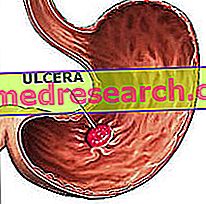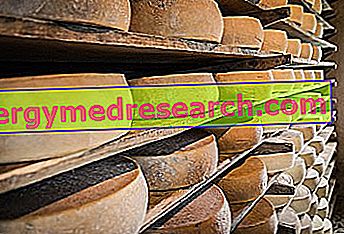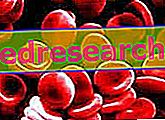Epidemiology
The maximum incidence of gastric ulcer occurs in male patients aged between 50 and 60 years. The male / female ratio is 3: 1. The average age is about 10 years higher than that of patients with duodenal ulcer.
The gastric ulcer appears with greater frequency in the lower social classes, but it is not clear if this is linked to particular dietary factors or to risky behaviors such as smoking, coffee intake, emotional stress, the use of drugs non-steroidal anti-inflammatory drugs, so-called NSAIDs.
Causes
The main cause of the ulcer is not known. However, numerous factors have been identified that, if coexistent, could cause their onset. Patients with gastric ulcers generally have a production of normal gastric acidity or slightly below normal; for this reason the most accredited hypothesis is that of a decrease in the resistance of the gastric mucosal barrier to the aggressive action of the acid-peptic secretion. The normal gastric mucosa is covered by mucus, secreted by superficial mucous cells, which contains proteins and bicarbonate. The protective action of the mucus, rich in bicarbonates, is carried out by maintaining a higher pH value in the mucosa than in the gastric secretion; a barrier is thus formed that prevents the acid from damaging the mucosa and the submucosa. Furthermore, the rapid replacement of epithelial cells in the stomach guarantees the rapid repair of any lesions due to the aggressive action of gastric juice. All the factors that are considered responsible for the onset of gastric ulcer are able to reduce the effectiveness of these defense mechanisms of the mucosa.

In 50-65% of patients with gastric ulcers there is the presence at the level of the pyloric antrum of Helicobacter pylori, a bacterium that is located below the mucosa. Helicobacter pylori is able to induce a local inflammatory reaction with activation of the immune system and to cause lesion of the epithelial cells of the mucosa itself.
Helicobacter pylori gastritis could therefore represent a predisposing factor to the onset of stomach ulcer .
Numerous external dietary and behavioral factors can facilitate the onset of gastric ulcer. Non-steroidal anti-inflammatory drugs (NSAIDs) reduce the concentration of bicarbonate in the mucus and inhibit the synthesis of prostaglandins, molecules that exert a protective action on the gastric mucosa. Also cortisone exerts damaging action on the mucosa, probably altering the mucous blood flow. Alcohol, ingested in large quantities, reduces the bicarbonate content in the mucus, although there is no sure evidence of an increased incidence of gastric ulcer in alcoholics. Caffeine can dramatically increase gastric acid production, as diet fats also decrease mucosal resistance to acid aggression, probably by depressing bicarbonate secretion in mucus. Cigarette smoke slows gastric emptying and increases reflux from the duodenum to the stomach, as well as reducing bicarbonate secretion.
There is also a genetic predisposition for the development of gastric ulcer: a greater incidence of the disease is found in subjects of blood group 0. Also the psychological factors seem to play a significant role in the appearance of gastric ulcer: individuals with fragile and dependent personality, or exposed to situations of high conflict or competition, they develop gastric ulcer with a higher frequency. It is also possible that the increased frequency of peptic ulcer is the result of eating habits and life at risk, such as smoking and coffee abuse, and dietary disorders.
Form and location of the ulcerative lesion
Most benign gastric ulcers arise within 6 centimeters from the pylorus; 85% of them are located along the small curvature of the stomach, while the remaining 15% is distributed on the anterior and posterior wall and along the large curvature.
The macroscopic aspect of benign gastric ulcer is that of an excavated lesion, round or oval, with a diameter usually less than 2 cm, which occurs on an inflamed mucosa due to gastritis.
At the bottom of the ulcer can sometimes be found vessels with blood clots or signs of a small bleeding in progress.
The depth of the ulcer is variable; it can overcome just the muscularis mucosae or it can reach the serosa and even overcome it, causing a free perforation in the peritoneum or deepening in neighboring organs and adhering to the stomach, such as the liver and pancreas.
Gastric ulcer symptoms
To learn more: Gastric ulcer symptoms
Some patients with gastric ulcer have no symptoms. When the presence of gastric ulcer becomes clinically evident, the onset symptom is commonly represented by epigastric pain (just below the sternum), of variable intensity, typically occurring within the first 30 minutes after a meal (early postprandial pain) . In ulcers located along the small curvature, antacids provide rapid pain relief, while food, after temporary well-being, can even lead to exacerbation.
Nausea and vomiting of gastric (food) contents may also be present. The appearance of sudden epigastric pain, followed by signs and symptoms of acute abdomen (very strong pain, such as a stab, abdomen of hard consistency, wood, tablet, nausea, vomiting, sweating, tachycardia, weak pulse and assumption of the crouched position on a hip) should lead to suspect the possible perforation of the peritoneum ulcer. 40% of those suffering from gastric ulcer report a variable weight loss, linked to anorexia and aversion to food induced by disorders.
Sideropenic anemia (due to iron deficiency), of varying degrees, may occur due to chronic hemorrhages resulting from gastric ulcer. The periodicity of the painful symptoms during the day can be added a seasonal periodicity, with characteristic accentuations in the spring and autumn period.
An aggravation of the symptoms may also occur as a result of sudden changes in eating or working habits, or after periods of psycho-physical or emotional stress.
The presence of non-periodic pain or of rapid and sudden modifications of the classical symptomatology must lead us to suppose the onset of complications or the non-peptic nature, but neoplastic gastric ulcer.
Diagnosis
The diagnosis of gastric ulcer should be differentiated from that of numerous other pathologies frequently encountered: hiatal hernia, gastritis, duodenitis, duodenal ulcer, gall bladder stones or chronic inflammation of the same and, particularly important, is the differential diagnosis with cancer of the stomach.
Confirmation of ulcer presence is endoscopic and radiological.
Endoscopic examination (gastroscopy) should be considered the first choice diagnostic approach; the direct visualization of the ulcer makes it possible to assess its size and shape, as well as to take samples (biopsy). On these biopsies, besides the histological examination, the search for Helicobacter pylori can be performed .
The radiological examination is performed with a baryta meal, that is marked with a fluorescent substance so that it can be seen on X-rays. Based on the speed or not of the passage of the contrast medium, it is possible with this examination to evaluate the emptying time gastric and other parameters.



